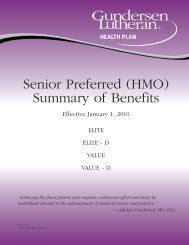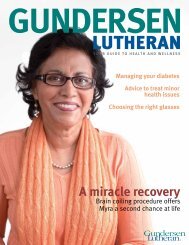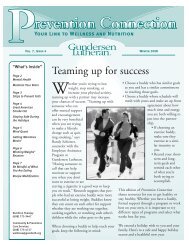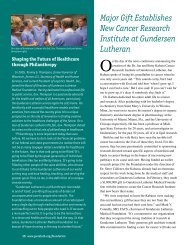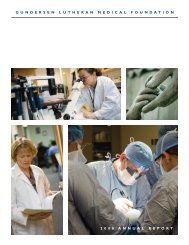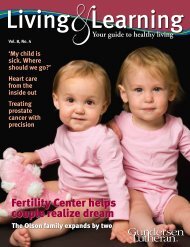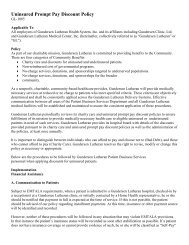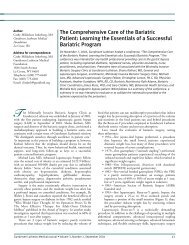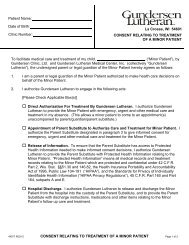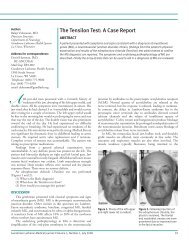BASIC ASEPSIS: - Gundersen Health System
BASIC ASEPSIS: - Gundersen Health System
BASIC ASEPSIS: - Gundersen Health System
Create successful ePaper yourself
Turn your PDF publications into a flip-book with our unique Google optimized e-Paper software.
<strong>BASIC</strong> <strong>ASEPSIS</strong>:<br />
A CRITICAL ELEMENT IN BREAKING THE CHAIN OF INFECTION<br />
Marilyn Michels, RN BSN CRRN CIC<br />
Standard Precautions and basic asepsis - Implementation of "Standard Precautions" is the<br />
primary strategy for successful prevention of healthcare associated infections of not only health<br />
care workers but also our patients. It contains the fundamental practices of infection control for<br />
the care of all individuals, regardless of their diagnosis or presumed infectious status. Effective<br />
use of personal protective equipment (PPE) can protect the health care worker from the patient’s<br />
infectious agents and vice versa. Since the development of Universal Precautions, there has been<br />
an emphasis on protecting the health care worker but we have forgotten message that these same<br />
practices can also protect the patient from infection if done correctly.<br />
Surgical Conscience (Four Components):<br />
Optimal patient care during invasive procedures requires the sound practice of asepsis coupled<br />
with surgical conscience. Surgical conscience incorporates knowledge of aseptic principles,<br />
perpetual attention to detail and experience. Open and honest communication is crucial for<br />
acknowledgement of questionable breaks in technique or risks to patient safety. Surgical<br />
conscience recognizes the intimate contact between the patient and the surgical team and<br />
includes attention to personal hygiene health. Employees should feel comfortable to call-in if<br />
they are ill. (Editorial in Annals of Surgery, 1950 pp315-18. Retrieved from<br />
http://www.ncbi.nlm.nih.gov/pmc/articles/PMC1616565/pdf/annsurg01395-0161.pdf)<br />
• Caring<br />
o Care enough to take care of yourself, know when to stay home.<br />
o Care enough to educate yourself and peers on the institution’s policies and<br />
procedures.<br />
o Care enough about your patients to develop a strong surgical conscience.<br />
• Conscience<br />
o Ability to see and correct breaks in technique.<br />
o Inner guide to do what is right, not what it is the easiest, fastest, or fear of retaliation.<br />
• Discipline<br />
o To follow policies and procedures that are in place.<br />
o To teach and mentor staff.<br />
o Always take the high road.<br />
• Technique<br />
o Assimilation of all these values with the knowledge of aseptic principles that develop<br />
over time.<br />
o Techniques evolve through time, trial, and error / quality improvement studies.<br />
o Be open-minded.<br />
o Seek out evidence-based practice to challenge or implement changes.<br />
Basic Asepsis Page 1
Aseptic technique - Aseptic technique is the effort taken to keep patients as free from hospital<br />
micro-organisms as possible (Crow 1989).<br />
• Sterile technique or surgical asepsis - A technique that restricts any microorganisms in the<br />
environment, on equipment and supplies from contaminating the wound or vascular system.<br />
It is the required technique for the use of critical items that enter sterile tissue or the central<br />
vascular system. At a minimum, sterile technique involves meticulous hand hygiene, use of a<br />
sterile field, sterile gloves for application of a sterile dressing and sterile instruments. Sterile<br />
technique may be expanded to include the use of clean attire, sterile surgeon gowns, surgical<br />
masks, hair covering and a controlled environment<br />
• Clean technique or medical asepsis - A technique that places emphasis on the prevention of<br />
cross contamination or transfer of microorganisms to the involved body site, other body sites<br />
of the patient, between patients or the environment. It requires the use of Standard<br />
Precautions for the protection of the employee from the patient’s body fluids, secretions, and<br />
excretions. It is appropriate for the use of semi-critical items that have contact with intact<br />
mucous membranes. Clean technique includes meticulous hand hygiene, a clean environment<br />
including a clean field, use of clean gloves, sterile instruments, and prevention of direct<br />
contamination of materials and supplies.<br />
Spaulding classification scheme<br />
Body Contact Disinfection Requirements FDA Device Class<br />
sterile body cavity sterilization critical<br />
mucous membranes high level semi-critical<br />
intact skin low level non-critical<br />
• Critical items - A category assigned to items that present a high risk of infection if the item<br />
is contaminated with any microorganisms, including bacterial spores. This category includes<br />
surgical instruments, cardiac catheters and indwelling urinary catheters, implants, and<br />
needles. Most of the items in this category should be purchased sterile or be sterilized.<br />
• Semicritical items - A category assigned to items that come in contact with mucous<br />
membranes or with skin that is not intact. These items must be free of all microorganisms,<br />
with the exception of high numbers of bacterial spores. Intact mucous membranes are<br />
generally resistant to infection by common bacterial spores but are susceptible to other<br />
organisms, such as tubercle bacilli and viruses. Respiratory therapy and anesthesia<br />
equipment, endoscopes, and diaphragm fitting rings are included in this category.<br />
Semicritical items generally require high-level disinfection with the use of wet pasteurization<br />
or chemical germicides (i.e. gluteraldehydes, chlorine). Terminal sterilization of instruments<br />
Basic Asepsis Page 2
is done to remove all pathogenic organisms before use on the next patient although items<br />
may be handled using clean technique during the procedure.<br />
• Noncritical items- A category assigned to items that come in contact with intact skin but not<br />
with mucous membranes. Intact skin acts as an effective barrier to most microorganisms.<br />
Examples of noncritical items include blood pressure cuffs, exam tables, electronic<br />
thermometers and furniture. Most items can be effectively cleaned with a hospital-grade<br />
disinfectant.<br />
Traffic patterns<br />
• Good traffic control patterns protect personnel, patients, supplies, and equipment from<br />
potential sources of cross-contamination. The practice setting should be designed to facilitate<br />
movement of patients and personnel into, through, and out of defined areas within procedure<br />
areas.<br />
• Movement of personnel is kept to a minimum while invasive or noninvasive procedures are<br />
in progress. Movement not only includes movement in an out of the procedure room but also<br />
movement within the procedure area.<br />
• The flow of clean and sterile supplies and equipment is separated from contaminated<br />
supplies, equipment, and waste by:<br />
o Space,<br />
o Time, or<br />
o Traffic patterns.<br />
• The surgical suite has three distinct areas defined by the activities that are performed in each<br />
area.<br />
o Unrestricted area: serves as the central control point established to monitor the<br />
entrance of patients, personnel, and materials. Street clothes may be worn in this area.<br />
o Semi-restricted area: is the peripheral support area that has storage areas for clean<br />
and sterile supplies, work areas and corridors leading to the restricted areas. Traffic is<br />
limited to authorized personnel and patients. Personnel are required to wear clean<br />
attire and cover all hair. No food or drink is allowed in this area.<br />
o Restricted area: includes the procedure/operating rooms, the clean core, and the<br />
scrub sink areas. Clean attire and hair covering is required. No food or drink is<br />
allowed in this area. Masks are required where open sterile supplies or scrubbed<br />
persons are located.<br />
Hygiene<br />
• Standard Precautions, a consistent method of taking precautions with body substances,<br />
should be applied to all patients at all time, irrespective of the diagnosis, in order to prevent<br />
the transmission of infectious agents.<br />
• All healthcare workers, visitors, and patients should have good hygiene practices.<br />
Basic Asepsis Page 3
o Hands with intact skin - <strong>Health</strong>y skin is less apt to harbor potentially dangerous<br />
organisms.<br />
o Free from upper respiratory illnesses - Sneezing, coughing and talking may contribute<br />
to the spread of organisms that may inhabit the upper respiratory tract.<br />
o All health care workers should be immunized against influenza to not only prevent<br />
the spread of influenza but also the spread of other common organisms from the<br />
upper respiratory tract, such as Staph aureus.<br />
• Respiratory Hygiene/Cough Etiquette: Targets patients and visitors with undiagnosed<br />
transmissible respiratory infections, and apply to persons with signs of illness including<br />
cough, congestion, rhinorrhea, or increased production of respiratory secretions when<br />
entering a healthcare facility. Elements include:<br />
o Education of healthcare facility staff, patients and visitors.<br />
o Posted signs, in language(s) appropriate to the population served, with instructions to<br />
patients and visitors.<br />
o Source control measures (e.g., covering the mouth/nose with a tissue when coughing<br />
and prompt disposal of used tissues, using surgical masks on the coughing person<br />
when tolerated and appropriate).<br />
o Hand hygiene after contact with respiratory secretions.<br />
o Spatial separation, ideally >3 feet, of persons with respiratory infections in common<br />
waiting areas when possible.<br />
o Vaccination against respiratory illnesses as appropriate including influenza, pertussis,<br />
and pneumonia.<br />
• Hand hygiene<br />
o Alcohol based gels<br />
• Gel in and Gel out- Waterless, alcohol-based hand rubs are now the preferred<br />
products for routine hand hygiene in healthcare settings, unless hands are<br />
visibly soiled. The CDC recommends that healthcare workers be provided<br />
with a readily available alcohol-based hand rub product at the entrance to each<br />
patient care room, at the patient’s bedside, or at other convenient locations.<br />
• Recommendations for increased use of waterless hand hygiene products do<br />
not negate the need for hand washing sinks. The efficacy of alcohol-based<br />
products or soap and water depends on the technique of the user.<br />
o Artificial fingernails or nail extenders are prohibited for those having direct contact<br />
with patients especially those at high risk (e.g. NICU. ICU, OR).<br />
o Soap - Hands should be washed with soap and water when visibly soiled with dirt or<br />
proteinaceous contaminates such as blood, other body fluids, secretions, and<br />
excretions, as soon as possible. Hands should also be washed with soap and water<br />
before eating and after using the restroom. Hands should be washed with soap and<br />
water (with or without gloves) if exposed (suspected or proven) to Bacillus anthracis,<br />
Basic Asepsis Page 4
Clostridum difficile, and some viral organisms such as Norovirus, Norwalk virus or<br />
Rotovirus.<br />
• Antimicrobial<br />
• Surgical scrub agents<br />
• Bar soap<br />
o Lotions – should be provided. Personal hand lotions are discouraged in the patient<br />
care area. Outbreaks have been traced back to contaminated lotion.<br />
o 5 Moments for Hand Hygiene from the World <strong>Health</strong> Organization includes Human<br />
Factors Engineering principals. It focuses on principals –not tasks and offers what we<br />
should do and the rationale. (See Hand Hygiene presentation for more information.)<br />
1. Before patient contact- prevents organisms of the healthcare environment<br />
(including the worker) from contaminating the patient or their environment<br />
Example – shaking hands<br />
2. Before aseptic task- immediately before touching site to be protected will prevent<br />
any organisms (patient’s or healthcare environment’s) from contacting the aseptic<br />
area. Examples: medication administration, IV line care, food prep<br />
3. After exposure to body fluids - protects self and environment from contamination.<br />
Examples: oral care, emptying urinals.<br />
4. After patient contact<br />
5. After contact with patient surroundings<br />
Items 4 & 5 above protects healthcare environment from patient contaminants.<br />
Examples: adjusting blanket of patient in hallway, adjusting IV flow rate.<br />
o Hand hygiene is the corner stone of infection prevention and control and is identified<br />
as the first step of Standard Precautions.<br />
o Ayliffe (1978) developed the Seven step hand washing technique<br />
1. Palms<br />
2. Backsides<br />
3. Between fingers<br />
4. Back of fingers<br />
5. Thumbs<br />
6. Fingertips<br />
7. Wrists<br />
Ayliffe SA et al (1978) A Test for Hygienic Hand Disinfection. Journal of Clinical Pathology. Vol 31, p<br />
923.<br />
o Alcohol-based rubs - follow the manufacturer’s recommendation for use;<br />
• Dispense an appropriate amount of product (2.5 grams) into one hand<br />
• Spread over both hands to wrists, interlace fingers and spread under<br />
fingernails, and rub into skin until dry (approximately 15-30 seconds)<br />
• Wash hands with soap and water after 8-10 applications of alcohol gel to<br />
remove accumulated emollients.<br />
o Soap (plain lotion soap) and water instructions are as follows:<br />
Basic Asepsis Page 5
• Wet hands with water<br />
• Apply soap products per manufacturer’s recommendations, usually 1-2 pumps<br />
from the dispenser or 3-5 mL.<br />
• Rub hands together vigorously, covering all skin surfaces and under rings<br />
• Rinse thoroughly<br />
• Dry hands with a disposable towel that is then used to turn off the water<br />
faucet.<br />
o Remember - Clean hands are the corner stone of standard and transmission-based<br />
precautions.<br />
Gloves<br />
• Purpose<br />
o Prevent exposure to healthcare worker<br />
o Protect the patient from hand contamination by the health care worker<br />
• Type<br />
o Vinyl<br />
• Not appropriate for tasks longer than 15-20 minutes in duration<br />
• No fit<br />
• Tear easily with stretching<br />
o Latex<br />
• Provides better protection than vinyl<br />
• Better fit<br />
• More elastic than vinyl<br />
• Sensitivity may develop with repeated exposure<br />
o Nitrile<br />
• Able to tolerate wider temperature variances<br />
• Better fit than vinyl<br />
o Others<br />
• One pair or double glove?<br />
o Need a set to remove the old dressing<br />
o A fresh pair of gloves is donned just prior to a procedure to prevent contamination of<br />
the field and procedure area. Gloves are promptly removed after removing<br />
contaminated items from the field, including the clean drape.<br />
o Double glove when tearing or puncturing of glove can be anticipated during the task<br />
(e.g. caring for trauma victim)<br />
o Extra gloves should not be stored in pockets with other personal items.<br />
• Clean or sterile<br />
o Hands should be cleaned before reaching into glove box.<br />
o Sterile gloves are:<br />
Basic Asepsis Page 6
• Recommended when doing dressing change on a fresh surgical wound that is<br />
not completely healed.<br />
• Required if inserting a sterile catheter or needle in deep tissue or body fluids,<br />
usually to obtain fluid or instill therapeutic agent.<br />
• Worn if handling instruments/supplies used for invasive procedures of sterile<br />
body cavities.<br />
• Selected based on a number of factors, including size, the task has to be<br />
performed, anticipated contact with chemicals, and chemotherapeutic agents,<br />
and latex sensitivity.<br />
Gowns<br />
• Impervious gowns (isolation gown, lab coat or non-sterile surgeon gown) are:<br />
o Worn when it is likely that personal clothing will be soiled with any patient's body<br />
fluids.<br />
o Laundered by the institution.<br />
• The need for and type of gown selected is based on the nature of the patient interaction<br />
including the anticipated degree of contact with infectious material and potential for blood<br />
and body fluid penetration of the barrier. Gowns may be worn not only to protect the clothing<br />
of the health care worker but may also provide clean/sterile attire.<br />
• Impervious gowns used for personal protection should not be worn outside of the area where<br />
the exposure was anticipated (e.g. blue lab coats should not be seen in the hallways).<br />
• AAMI Level 1 gown is typically used for isolation gowns or standard precautions. There is a<br />
consistent level of barrier protection throughout the gown – no reinforced areas.<br />
Basic Asepsis Page 7
Masks<br />
• Mask<br />
are used for three primary purposess in healthcare settings:<br />
• Placed on healthcare personnel to protectt them from contact with<br />
infectious material from<br />
patients (e.g., respiratory secretions and sprays of blood or body fluids, consistent with<br />
Standard Precautions).<br />
• Placed on healthcare personnel when engaged in procedures requiring sterilee technique to<br />
protect patients from exposure to infectious agents carried in a health-care worker’s mouth or<br />
nose.<br />
Basic Asepsis Page 8
• Placed on coughing patients to limit potential dissemination of infectious respiratory<br />
secretions from the patient to<br />
others (see Respiratoryy Hygiene/Cough Etiquette, CDC’s<br />
Guideline for Isolation Precautions).<br />
• Procedural maskss are the least effective and are not appropriate in a surgical setting.<br />
• Surgical masks are tie masks and provide<br />
better protection than procedure masks (ear-loop<br />
masks)<br />
Respiratory Protection<br />
• To protect the health care worker – should be worn consistently with bronchoscopy<br />
procedures<br />
• Primarily designed to protectt the health care worker from droplett nuclei but some designs<br />
may also protect the patient from aerosols from the health care worker<br />
Eye Protection<br />
• Worn<br />
to protect the eye and face from infectious materials.<br />
• The degree of protection required depends upon the circumstances of exposure, other PPE<br />
used,<br />
and personal vision needs.<br />
• Personal eyeglasses and contact lenses are not considered adequate for eye protection.<br />
Basic Asepsis Page 9
All Personal Protective Equipment (PPE) should be promptly removed after completing the<br />
procedure or when there is no longer a risk of exposure. PPE should<br />
not be seen<br />
in the hallway<br />
or outside of the procedure area.<br />
Dressing<br />
changes for patients with chronicc wounds<br />
Minor invasive procedures<br />
• Must<br />
do<br />
o PPE – sterile gloves<br />
o Skin prep<br />
o Sterile drape<br />
• Remove hair only<br />
if necessary – seldom necessary. Do not use a razor but clip. Consider<br />
implementation with IV starts, electrode placement on patients anticipated to<br />
require heart<br />
surgery, etc.<br />
• Prepare skin<br />
o Approved scrub agent<br />
o Select based on location and patient’s<br />
sensitivity<br />
o Follow instructions<br />
• Drape<br />
Basic Asepsis Page 10
• Sterile items – check processing and package integrity<br />
o Peel packs<br />
• Package integrity<br />
• Not wet<br />
• Completely sealed<br />
• Not punctured<br />
• Check for outdates<br />
• Flip technique to place on field<br />
o Wrapped<br />
• Inspect package<br />
• Ensure integrity<br />
o Instrument pans:<br />
• Locks<br />
• Filter in place<br />
• Tracking tag in place<br />
o High level disinfection<br />
• Monitor field once sterile items are opened<br />
Clean Technique (Medical Asepsis)<br />
• Supplies, Instruments and Utensils:<br />
o Have established protocols for handling all supplies and instruments<br />
o Manually remove debris from instruments with damp gauze or flush with water<br />
immediately after use to facilitate cleaning<br />
o Place grossly soiled instruments in a rigid leak resistant container with appropriate<br />
soaking solution and cover.<br />
o Hands are never used to retrieve objects from opaque solution since liquid may<br />
obscure reusable sharps.<br />
o Rinse grossly soiled utensils and place in designated soiled receiving area for future<br />
processing, which is to be ideally done by Central Services.<br />
o Use processing solutions which are approved by the Infection Control Committee and<br />
for their intended use only.<br />
• Equipment:<br />
o Surfaces should be cleanable<br />
o Clean equipment with a disinfectant before use by another patient, i.e., cautery unit,<br />
etc.<br />
o Items are cleaned with a disinfectant before return to central storage area, and before<br />
repairs or preventative maintenance.<br />
o Large equipment returned to CS is wiped down before transport.<br />
• Trash<br />
o Bag all trash and disposable items to prevent leakage.<br />
Basic Asepsis Page 11
o Gather trash at the end of the procedure by personnel wearing gloves. Trash is<br />
typically removed with the liner but small amounts from non-patient care areas may<br />
be dumped into another larger container. Trash is never removed by reaching into<br />
containers by hand.<br />
o Place all infectious waste in biohazard labeled red bags.<br />
o A biohazard bag is available in patient care areas to use during procedures.<br />
o Drainage units that have a drain port are emptied in the Decontamination area in<br />
Central Services using engineering controls or not emptied at all. Place emptied<br />
drainage units in infectious waste container for disposal. Every attempt must be made<br />
to use available engineering controls to empty drainage units. This may include use<br />
of closed drainage systems or hopper shields. If Engineering Controls are not<br />
available, the appropriate personal protective equipment must be worn.<br />
Room cleaning:<br />
• Daily and terminal cleaning of the exam/procedure room is performed consistently, including<br />
prompt cleanup of body substances and/or spills by gloved personnel using an EPA approved<br />
disinfectant.<br />
• Daily disinfect frequently touched surfaces with an EPA approved hospital disinfectant.<br />
There is a continuum between clean technique and sterile technique.<br />
Surgical Asepsis (Sterile technique)<br />
• Assessed prior to the procedure - Patients are assessed prior to the procedure for any signs or<br />
symptoms of an infectious process. The following are reported to the surgeon and<br />
anesthesiologist for final decision if the patient is a surgical candidate:<br />
o Core temperature > 38.5 Celsius<br />
o Productive cough, runny nose, sore throat, and any other symptoms of a respiratory<br />
infection.<br />
o Pyuria > 10 WBCs/hpf<br />
o Elevated WBC<br />
o Diarrhea with abdominal pain<br />
o Any purulent material or lesion of the skin or subcutaneous tissue in proximity to the<br />
operative site. This includes any abraded or burned skin<br />
o Any recent exposure to communicable disease that may lead to subsequent disease<br />
(e.g., chickenpox exposure to those w/o immunity).<br />
• Skin preparation<br />
o The patient is instructed to bathe the night before and/or the morning of surgery<br />
according to an established protocol.<br />
o Pre-surgical scrubs and clips are preformed only if necessary and then according to<br />
individual surgeon preference for that specific procedure.<br />
Basic Asepsis Page 12
o Consider decolonization of patient with known methicillin resistant Staphylococcal<br />
aureus (MRSA) colonization or infection.<br />
• Patients requiring transmission based precautions<br />
o Established protocols for patients with a multiple drug resistant organism (MDRO) or<br />
any other infection requiring Contact or Droplet Precautions<br />
o Place patients with uncontrolled drainage from wounds in Contact Precautions.<br />
o Patients requiring Airborne Infection Isolation (AII) Precautions should be scheduled<br />
in surgical suite with a negative pressure anteroom and recovered in the same<br />
operating room or in another Airborne Infection Isolation (AII) room. Staff must<br />
wear the appropriate personal protective equipment during isolation. Respiratory<br />
protection should not have an exhalation valve or exhausted without a filtration<br />
system in place to protect the patient from pathogens from the health care workers<br />
upper respiratory tract.<br />
o Regardless of isolation status – all patients entering the surgical suite should have<br />
freshly laundered linens donned after their evening/morning shower or bag bath. Hair<br />
will be covered just prior to entering surgery. Trend to make a slight revision for<br />
Ophthalmology patients. They may wear their street clothes from the waist down and<br />
a clean patient gown if they are cocooned in freshly laundered linens. This only<br />
applies if the patient will remain on the eye cart throughout the surgical procedure.<br />
o All patient contact requires Personal Protective Equipment (PPE), typically gown and<br />
gloves. It is important that hands are washed after removing the gown, gloves, and<br />
other PPEs. Mask and goggles should be added with anticipated contact with blood or<br />
body fluids with possible splash, splatter or spray to the face or eyes..<br />
o After the patient is draped in the OR, the circulator does not have to wear the<br />
isolation gown and gloves. Anesthesia should continue to wear gown and gloves<br />
when in direct contact with the patient.<br />
o Avoid contaminating items in surgery suite while wearing gown and gloves.<br />
Surgery Scrub – Hand Antisepsis<br />
• Wash hands at the beginning of the shift prior to and after performing the procedure, prior to<br />
entry into semi-restricted or restricted areas, and on exit of semi-restricted or restricted areas.<br />
• No artificial fingernails or nail extenders<br />
• Remove jewelry, don eye and face protection and do a final check to be sure all hair is<br />
secured.<br />
• Clean nails under running water<br />
• Apply antiseptic per posted manufacturer recommendations. Specific manufacturer<br />
instructions are to be posted by the scrub sink for easy reference.<br />
• Dry with sterile towel completely before gloving<br />
• When using an alcohol-based surgical hand rub product (with persistent activity), the hands<br />
and forearms should be pre-washed with plain lotion soap and dried completely.<br />
Basic Asepsis Page 13
Clean Attire<br />
• Before donning surgical attire, all persons entering the perioperative suite should wash their<br />
hands with soap and water, antiseptic and water, or an antiseptic hand rub if visible soil is not<br />
present upon arrival.<br />
• Facility-approved, clean, and freshly laundered surgical attire should be donned in a<br />
designated dressing area of the perioperative suite before entry or reentry into the<br />
semirestricted and restricted area.<br />
• All individuals who enter the semirestricted and restricted areas of the perioperative setting<br />
should wear freshly laundered or disposable surgical attire intended for use within the<br />
perioperative setting.<br />
• All non-scrubbed personnel should wear a long-sleeved jacket snapped closed with the cuffs<br />
pulled down to the wrists<br />
• All attire is changed daily or more often whenever they become visibly soiled or wet. The<br />
two piece pant suit should be sized appropriately to prevent pant legs from dragging and<br />
provide adequate coverage. The top should fit snuggly at the hips or be tucked in to the pants.<br />
• Wearing clean attire is limited to the inside of the institution. This does not include the<br />
grounds of the institution or residential housing. Clean attire should be completely covered<br />
with clean jumpsuit if worn outside during the course of job-related duties (e.g. walking from<br />
hospital to pack room, etc.).<br />
• Duty shoes are kept clean and not worn outside. Shoe covers are only worn with reasonable<br />
anticipation of exposure to blood or potentially infective material. Shoe covers are removed<br />
following the procedure upon leaving the room. Shoe covers should not be worn as a<br />
substitute to having duty shoes. Hose or socks are worn.<br />
• Long sleeved jackets or warm-up jackets should be worn by all non-scrubbed personnel in<br />
the central core or the operating room. Long sleeved jackets should be snapped close and<br />
changed daily or whenever possible contamination may have occurred. Clothing that cannot<br />
be covered by the clean surgery attire should not be worn.<br />
• All jewelry is contained within scrub attire.<br />
• All possible head and facial hair, including sideburns and neckline, should be covered. A<br />
hood is worn if scrub caps do not cover hair. Reusable hair coverings should be laundered<br />
after each use by an accredited laundry services. Single use hair covering is discarded at the<br />
end of the shift.<br />
• Surgical attire helps contain bacterial shedding and promotes environmental control. An<br />
individual sheds millions of skin squames daily. Five percent to 10% of skin squames have<br />
bacteria.<br />
• Surgical attire that has been worn during one shift has higher bacterial colony counts at the<br />
end of the work shift when scrub clothing is removed, or when stored in a locker and used<br />
again. Worn surgical attire should be placed in an appropriately designated container for<br />
laundering and should not be hung or placed in a locker for wearing at another time.<br />
Basic Asepsis Page 14
• Wearing the warm-up jacket snapped closed prevents the edges of the front of the jacket<br />
from contaminating a skin prep area or the sterile surgical field. Long-sleeved attire contains<br />
skin shedding from bare arms. When in the semirestricted or restricted areas, all nonscrubbed<br />
personnel should wear a long-sleeved jacket snapped closed with the cuffs pulled<br />
down to the wrists.<br />
• Surgical attire should be laundered in a health care-approved or accredited laundry facility.<br />
• Surgical attire should not be washed in the home.<br />
• Wash hands after removing gown and gloves or any personal items.<br />
• Shoe covers should be changed whenever they become torn, wet, or soiled and discarded in a<br />
designated container before leaving the surgical area.<br />
• Protective shoes must be worn in the perioperative environment. Shoes should have closed<br />
toes, low heels, and non-skid soles.<br />
• Shoes worn within the perioperative environment should be cleaned regularly and have no<br />
visible soiling.<br />
Masks<br />
• The need and the type of mask selected (e.g. surgical, PAPR, N95 respirators, HEPA) should<br />
be selected based on the infectious agent involved and the anticipated level of exposure.<br />
Medical PAPRs typically are not approved for use in a surgical setting with an open sterile<br />
field.<br />
• Masks are worn during invasive procedures or when the sterile items are open.<br />
• Masks are worn to completely cover the nose and mouth and secured to prevent venting at<br />
the sides.<br />
• Masks are either on or off; they are not to be tucked into a pocket or worn hanging around<br />
the neck.<br />
• Masks are generally changed between cases. Exceptions can be made for supervising staff or<br />
others that are in several rooms for brief periods of time.<br />
• Masks are worn by staff cleaning between cases due to the short turn-around time of rooms.<br />
• When removing the mask, touch only the strings to reduce contamination of the hand from<br />
the nasopharyngeal area.<br />
<strong>Health</strong> care workers should know their status for possible infection with Blood Borne<br />
Pathogens (BBP) if they are at risk of exposure<br />
All surgeons and surgery staff that scrub-in should know their baseline status for<br />
Hepatitis B (HBV), Hepatitis C (HCV) and human immune-deficiency virus (HIV)<br />
infection. All possible exposures to blood borne pathogens should be promptly reported.<br />
It is not uncommon to have a dual exposure during a surgical procedure whereby the<br />
patient becomes exposed to the health care worker's blood. There should be a system in<br />
place to handle dual exposures. Surgeons and surgery staff with known HBV, HCV or<br />
Basic Asepsis Page 15
HIV infection should consult with an advisory panel for ongoing follow-up. (Reference:<br />
Infection Control and Hospital Epidemiology March 2010, Vol. 31, No. 3)<br />
Skin Prep<br />
• The operative site and surrounding areas should be cleaned before entry into procedure room<br />
(i.e., pre-op shower & shampoo).<br />
• Hair should be removed prior to transport to operative/procedure area. Hair removal should<br />
be done only with a clipper or a chemical depilatory and only when absolutely necessary to<br />
facilitate wound closure and dressing. Hair removal should occur as close to incision time as<br />
possible.<br />
• There should be a documented assessment of the operative site, which notes the presence of<br />
skin lesion.<br />
• The operative site and the surrounding area should be prepped with an approved surgical<br />
scrub agent.<br />
• Surgical scrub agents should be selected based on patient sensitivity, incision location, and<br />
skin condition.<br />
• Surgical scrub agents should be used according to the manufacturer’s recommendations.<br />
• Skin lesions or open areas should be prepped according to established protocols.<br />
• Antimicrobial agents should be applied using sterile supplies and sterile gloves. Scrub jackets<br />
should be worn during the prep as long as this does not contaminate the prepped area. The<br />
antimicrobial agent should be applied proceeding from the incision site to the periphery with<br />
the exception of Chloraprep. Surgical scrub agents should not be allowed to pool under<br />
patient.<br />
• Documentation of the skin prep should include assessment of the skin integrity, hair removal<br />
process, area prepped, solutions used, abnormal reaction to prep, and name of person(s)<br />
performing the task.<br />
Sterile Gown<br />
• Sterile gowns and gloves should be worn by scrubbed personnel.<br />
• Sterile gowns should be available with various levels of protection. The standard surgeon<br />
gown is classified per ANSI/AAMI PB270:2003 standard as a Level 2 Barrier. Level 2<br />
barrier gowns are appropriate for short procedures with little or no anticipated exposure to<br />
blood or body fluids. As the length and physical contact of the procedure increases there<br />
should be consideration to select a gown with greater barrier properties.<br />
• Scrubbed personnel should don a sterile gown and sterile gloves from a sterile field other<br />
than the instrument table.<br />
Basic Asepsis Page 16
AAMI Classification Levels of Barrier Performance<br />
Level Test Result Exposure Risk<br />
1 Impact Penetration
Gloves<br />
• Gloves are inspected after donning.<br />
• Double gloving is recommended for most procedures.<br />
• Blue indicator polyisoprene surgical gloves are available as the under glove when double<br />
gloving. The blue indicator glove allows for easier detection of holes in the outer surgeon<br />
glove. Perforation indicator systems results in significantly more innermost glove<br />
perforations being detected during surgery.<br />
• It is generally recommended to change the outer glove every two hours.<br />
• Double gloving may reduce the rate of surgical site infections if perforations are detected<br />
sooner or the barrier remains intact.<br />
Draping<br />
• Inspect for holes as establishing the sterile field<br />
• Handle as little as possible<br />
• During the draping the process the sterile drape is held folded and compact above the<br />
operative area, then placed and unfolded from the operative site to the periphery starting with<br />
the side closest.<br />
• Cuff drape over hands during draping process<br />
Sterile field<br />
• All items used within the sterile field should be sterile.<br />
• All items presented to the sterile field should be checked for proper processing and package<br />
integrity.<br />
• Items introduced onto a sterile field are opened, dispensed, and transferred by methods that<br />
maintain sterility and integrity.<br />
• Wrapped supplies should be opened by un-scrubbed personnel by opening the wrapper<br />
farthest from them first and the nearest wrapper flap last.<br />
• All wrapper edges are secured when supplies should be presented to the sterile field to<br />
prevent contamination.<br />
• Tables are sterile only at table level.<br />
o Anything over the edge should be considered unsterile, such as a suture or the table<br />
drape.<br />
o Should use non-perforating device to secure tubing and cords to prevent them from<br />
sliding to the floor.<br />
• Sterile items should be presented to the scrubbed person or placed securely on the table.<br />
• Objects that are sharp, heavy or difficult to handle should be presented to the scrubbed<br />
person or opened on a separate surface.<br />
• Solutions should be dispensed by:<br />
o Pouring the entire contents into the receptacle or the remainder is discarded.<br />
Basic Asepsis Page 18
o The receptacle is placed near the edge of the table or held be the scrubbed person, and<br />
the fluid is poured slowly to avoid splashing.<br />
• The sterile filed should be constantly monitored, once unguarded it should be considered<br />
contaminated<br />
• Opened instruments should not leave room of intended use.<br />
• Do not cover sterile field to save until later because it is difficult to remove drape without<br />
contaminating the sterile filed.<br />
• Once the patient enters surgical suite, all items should be considered contaminated to that<br />
case<br />
• Scrubbed persons should keep their arms and hands within the sterile area at all times<br />
• Movement around the sterile field should be done in a manner to maintain the integrity of the<br />
sterile field.<br />
• Conversation should be kept to a minimum once the sterile items have been opened. There<br />
should be no gum chewing under the mask.<br />
Sanitation<br />
• Patients should be provided with a safe, clean environment free from dust and organic debris.<br />
• Cleaning should be done on a scheduled basis to prevent cross-contamination.<br />
• Furniture, lights, and equipment should be damp dusted with approved disinfectant before the<br />
first scheduled case.<br />
• The area should be visually inspected before the instruments are brought into the room.<br />
• External packing containers used during shipping should be removed before materials are<br />
transported into the procedure/operating room. The integrity of all packages should be<br />
maintained.<br />
• Equipment from outside the procedure room should be damp dusted with an EPA approved<br />
germicidal agent prior to entry into the procedure/operating room. This includes but is not<br />
limited to items stored in outer corridor.<br />
• Patients should be brought into the procedure/operating room with freshly laundered linens<br />
and gown.<br />
• During the procedure, all activities should be directed at confining and containing<br />
contamination.<br />
• There should be a prompt clean-up of contaminated surfaces with an approved disinfectant.<br />
• Spray bottles should not be used during the procedure or set up.<br />
• The patient's bed from the nursing unit should be cleaned with an approved disinfectant and<br />
freshly laundered linen should be applied.<br />
• Items that come in contact with the patient and/or sterile field are considered contaminated.<br />
• Disposable items with squeezable, dripable, pourable blood are placed in closeable, leakproof<br />
containers or red bags that are labeled with the biohazard symbol. Used/unused or<br />
soiled disposable items are placed in the properly defined disposal receptacles.<br />
Basic Asepsis Page 19
• Gowns and gloves should be removed in a manner that contains contamination and gowns<br />
and gloves placed in the proper receptacle prior to leaving the procedure/operating room.<br />
• Contaminated linen should be handled as little as possible. Linen from any open packs,<br />
whether soiled or not, should be placed in linen hampers for the laundry.<br />
• Instruments should be placed by the gloved scrub person directly into instrument trays and<br />
placed in case cart.<br />
• Disposable suction containers should be sealed and either sent to central processing area for<br />
disposal or emptied in designated soiled area by an individual wearing the appropriate PPE.<br />
• All needles, sponges, instruments should be counted when there is a likelihood of items to be<br />
retained before disposal.<br />
• Sponges should be discarded into or onto impervious surface for counting.<br />
• Personnel should use gloves in handling sponges, organic material, and specimens.<br />
Between Case Cleaning<br />
• All surfaces should be disinfected between cases – know wet contact time claim<br />
• Clean from the top to bottom (cleanest to dirtiest)<br />
• Disinfect all surfaces that could be possibly contaminated<br />
o Includes area for circulator<br />
o Lead aprons/shields<br />
o Keyboards<br />
o Door panels<br />
o Phone<br />
• Remove all debris from floor before mopping/wet vac (includes bone chips)<br />
• The area mopped is dependent upon the likelihood of contamination. Some procedures are<br />
minimally invasive and there is no blood loss therefore floor disinfection is not necessary.<br />
Floors are cleaned with an approved disinfectant. A mop- head is used only once and not<br />
double dipped. It may require several mopheads to clean the floor.<br />
• Scrub sinks should be cleaned after the scrub for each case<br />
Term cleaning<br />
• Terminal/daily cleaning of the procedure/operating room should be done at the conclusion of<br />
the day’s schedule.<br />
• The areas to be cleaned include; lights, ceiling mounted equipment, all furniture including<br />
the wheels and casters, handles and pushes plates, face plates and vents, all horizontal<br />
surfaces, the entire floor, kick buckets, and scrub sinks.<br />
• Thermostats should be set at 72 degrees Fahrenheit or warmer. Terminal/daily cleaning is<br />
also done in the related locker rooms, corridors, rest-rooms, workrooms and storage areas.<br />
• Break rooms should be cleaned at least daily but typically need to be cleaned more often to<br />
keep trash to a minimum. Doors to break rooms should be kept closed at all times.<br />
Basic Asepsis Page 20
Weekly/Monthly Cleaning<br />
• Weekly damp dusting should be done for refrigerators, crash carts, supply carts, med carts,<br />
desks, tables, and case carts in the restricted areas..<br />
• Monthly cleaning of clean storage areas/shelves should be done with monthly checks for<br />
outdated supplies. This includes refrigerators, freezer, crash cart, etc. and med cart. The<br />
following should be cleaned monthly: gas tracks, light fixtures, and the vents in the clean<br />
storage areas and corridors.<br />
Ventilation<br />
• The surgical area should have positive ventilation pressure in relationship to the adjacent area<br />
• There should be a minimum of 4 outside air changes per hour<br />
• There should be a minimum of 20 air changes per hour<br />
• The relative humidity should be 30-60%<br />
• There should be no air recirculation unity in the procedure room<br />
• The temperature control should be 68-75 degrees Fahrenheit.<br />
• Guidance ASHREA/ASHE Standard Ventilation of <strong>Health</strong> Care Facilities<br />
o Check for duct cleanliness<br />
o Check for balance of the ventilation system.<br />
Syringes, Needles and Disposables<br />
• Safety devices should be used whenever appropriate and available (blunt suture needles,<br />
blunt needle system, safety syringes, etc.).<br />
• Safety device should be activated before disposal.<br />
• Sharps may be place in a rigid, plastic leak-resistant, with a closable container.<br />
• Needles should not be broken, bended, or recapped before disposal.<br />
• Sharps containers should be sealed when two-thirds full and placed in designated area for<br />
pick up.<br />
Injection Safety<br />
• Injection safety includes practices intended to prevent transmission of infectious diseases<br />
between one patient and another, or between a patient and healthcare worker and also to<br />
prevent harms such as sharp injuries.<br />
Laboratory Specimen<br />
• All blood, body fluids and tissue specimens should be placed in a clean impervious container<br />
for transport.<br />
• Specimens from all patients are handled with care.<br />
• The outside of a soiled specimen container is cleaned with a disinfectant.<br />
Basic Asepsis Page 21
• All specimens must be bagged in a clean leak-proof clear bag for transportation to the lab.<br />
Any specimen that is not in recognizable standard specimen container needs a biohazardous<br />
label before transport. Visibly soiled containers may be rejected by the laboratory. All<br />
specimens leaving the institution need a biohazard label.<br />
• Specimens that require other precautions in addition to Standard Precautions are labeled (i.e.<br />
AFB/ Airborne Infection Precautions on lung tissue from a known/suspect TB case).<br />
• Hands are washed after transporting specimens to the laboratory.<br />
• Specimens sent through the tube system should be sealed and double bagged. Liquid<br />
specimens are sealed in containers with a screw-on lid and bagged.<br />
• No specimens should be given directly to the patient. All requests for specimens should be<br />
processed following the approved protocols and the physician before being allowed to leave<br />
the institution.<br />
• Amputated limbs, appendages or fetus are not considered infectious waste although they do<br />
need to be handled with precautions. Limbs should be placed in an orange bag for special<br />
handling by Pathology or Central Services.<br />
Care of Instruments<br />
• Immediate use sterilization should not be used as a substitute for sufficient instrument<br />
inventory or late delivery of loaner sets.<br />
• Instruments should be used only for the specific purpose for which they were designed.<br />
• Instruments should be kept free of gross soil during the procedure.<br />
• A sponge moistened with sterile water should be used to wipe debris from the instrument<br />
during the procedure.<br />
• Lumens should be kept patent by sterile water irrigation.<br />
• All items in contact with the patient and/or sterile field should be considered contaminated to<br />
that specific case. This includes but is not limited to: instruments, sponges, drapes, suture,<br />
equipment, and furnishings. All contaminated items should be cleaned at the end of the case.<br />
If the case cart has been assigned to a specific case, it should be used to return the<br />
contaminated items back to the central processing area. Suction canisters should be secured<br />
in a manner in the case cart to prevent spills during transit (e.g. place canister in basin).<br />
Laundry and trash bags should be removed from procedure room through the outer corridor.<br />
Transit should not occur through sterile storage areas.<br />
• Reuse of single use devices is prohibited unless reprocessing is done by an FDA approved<br />
facility. Open and unused items should be kept to a minimum but may be reprocessed by an<br />
FDA approved facility.<br />
• The decontamination process should begin immediately after completion of the invasive<br />
procedure. Disinfection practices outside of the central processing area should be consistent<br />
with practices within the central processing area.<br />
• Personal protective equipment (PPE) should be used during the decontamination process.<br />
Basic Asepsis Page 22
• Manual cleaning should be done in a manner to limit aerosolization and splashing of<br />
infectious material. Spray bottles of disinfectant should not be used during the case although<br />
disinfectant wipes may be used.<br />
• Prolonged soaking of dirty instruments should be avoided to prevent damage of instrument<br />
surfaces. Enzymatic soaking of instruments is generally considered safe for several hours.<br />
• Decontamination should be done in a designated soiled area.<br />
• Manufacturer’s written instructions should be followed for the detergent selection and the<br />
proper use, care, and maintenance of the instruments.<br />
• Instruments with movable parts should be lubricated after every cleaning and according to<br />
the manufacturer’s written instructions.<br />
• Instruments should be inspected and prepared for storage and/or sterilization following the<br />
cleaning process.<br />
• Instruments should be checked for cleanliness, proper functioning and alignment, freedom<br />
from defects, sharpness of cutting edges, looseness of pins, and chipping of surfaces.<br />
• Instruments should be dried and then stored.<br />
• Instruments with removable parts are should be disassembled and placed in trays designed<br />
for sterilization. Ring-handled instruments should be secured in a manner that retains an open<br />
position.<br />
• Delicate sharp instruments should be protected during the decontamination process.<br />
Endoscope Reprocessing (See presentation on Endoscope Reprocessing for more details.)<br />
• Endoscopes should be inspected, tested, and processed according to design and type and<br />
manufacturer’s written instructions.<br />
• Endoscopes should be handled so as to prevent damage to lenses and fiberoptic components.<br />
• Endoscopes should be disassembled, thoroughly cleaned manually, and dried before<br />
sterilization or high level disinfection.<br />
• Disinfected endoscopes should be thoroughly rinsed with sterile water and dried before<br />
storage.<br />
• Accessories should be decontaminated, cleaned, and sterilized according to the<br />
manufacturer’s written instructions.<br />
• The disinfected endoscope should be rinsed again immediately before use.<br />
Powered Instruments<br />
• Powered surgical instruments should be decontaminated, cleaned, and sterilized according to<br />
the manufacturer’s written instructions.<br />
• Powered surgical instruments should be inspected, tested, and used according to the<br />
manufacturer’s written instructions.<br />
• Powered surgical instruments should be packaged and sterilized before use according to the<br />
manufacturer’s written instructions.<br />
Basic Asepsis Page 23
• Exposure times for steam and EtO sterilization of powered surgical instruments should be<br />
done according to the manufacturer’s written instructions.<br />
References<br />
Perioperative Standards and Recommended Practices, 2011 Edition by AORN<br />
Basic Asepsis Page 24
Remove all jewelry and piercings before surgery<br />
You cannot wear jewelry of any kind during<br />
surgery. You could be injured. Even if you<br />
have a new piercing that has not fully healed,<br />
it must be removed before surgery. These are<br />
some of the risks of leaving jewelry and body<br />
piercings in place.<br />
• Some tools use electricity to close blood<br />
vessels and perform other functions. Metal<br />
jewelry can conduct current and cause<br />
burns.<br />
• Piercings in and around your mouth might<br />
come loose. When a breathing tube is put<br />
into your throat, you might swallow or<br />
breathe in part of a piercing set.<br />
• Your skin or tissues could be damaged if<br />
you lie on jewelry. You will not feel pain or<br />
be able to shift your weight to relieve<br />
pressure.<br />
• Jewelry that appears on x-rays and other<br />
tests can disrupt the correct reading of<br />
images needed for your care.<br />
• Infection can occur if the piercing site is<br />
new or not well healed.<br />
You will be asked to remove all of your<br />
jewelry before surgery. The pre-op nurses can<br />
help you if needed. If you have a new piercing<br />
and do not want to remove the piercing for a<br />
long period of time, you may be able to use a<br />
plastic, metal-free retainer. You must talk with<br />
your surgeon to make sure this is okay.<br />
In pre-op, the nurse must see and record that<br />
all jewelry has been removed. All pieces will<br />
be placed in a plastic bag and put in a safe<br />
place. It will be returned to you after surgery.<br />
You may put your jewelry back on if it is not<br />
near the incision.<br />
• Jewelry can catch on something and be<br />
ripped out.<br />
• A staff member who must place a urine<br />
catheter will have trouble working around<br />
jewelry in your genital area.<br />
This content supports the care you receive from your health care team. It does not replace medical care or advice. Talk to your doctor or others on your<br />
health care team before you start any new treatment. Content goes through routine review by experts on our staff.<br />
08/20/2010<br />
PE 001301 The right information for our patients<br />
Page 1 of 1
Methicillin-Resistant Staphylococcus aureus (MRSA)<br />
Staphylococcus aureus is a common type of<br />
bacteria. It is better known by its nickname,<br />
“staph” (staf). For most of us, staph is harmless<br />
most of the time. It can live on your skin or in<br />
your nose without causing problems. But if it<br />
infects a wound, your blood or your lungs, it can<br />
make you very sick.<br />
Methicillin-resistant Staphylococcus aureus<br />
(MRSA) is a strain of staph that resists some<br />
antibiotic treatment. Some call it a “super bug”,<br />
but it is no joke. Few drugs can control MRSA<br />
after it infects someone.<br />
Does everyone exposed to staph<br />
or MRSA become infected?<br />
No. Some become colonized. Being colonized<br />
means staph bacteria are on your body but do not<br />
infect you. They may live and grow in your:<br />
• Nose<br />
• Sputum (what comes out of your throat<br />
after deep coughs)<br />
• Urine and sex organs<br />
At least one-third of the general population is<br />
colonized with staph. Of these, only a small<br />
number are colonized with MRSA.<br />
Why and where do “staph”<br />
infections occur?<br />
Staph can infect people with injured skin or<br />
chronic illness. One type of staph is more<br />
common in places where there are large groups of<br />
people. These include hospitals, nursing homes<br />
and dialysis centers. <strong>Health</strong>care associated MRSA<br />
(HA-MRSA) may infect:<br />
• Wounds<br />
• Urinary tract<br />
• Blood<br />
• Lungs<br />
11/19/2008 continued...<br />
PE 000490<br />
About half of those who have a chronic illness<br />
are colonized. They tend to be in the hospital<br />
more often than people whose immune systems<br />
are strong enough to resist staph.<br />
What is community-associated<br />
MRSA (CA-MRSA)?<br />
This type is found in places other than hospitals<br />
and health care buildings. It can infect people<br />
who have not:<br />
• Been cared for in a hospital within the past year<br />
• Had surgery, dialysis, catheter placement or<br />
another procedure.<br />
CA-MRSA can cause red or infected bumps on<br />
your skin. Your health may be fine except for<br />
what looks like a severe skin problem. If you<br />
have this symptom, do not take it lightly. See a<br />
doctor. You may need tests as well as treatment.<br />
CA-MRSA can spread among children in day<br />
care, athletes who play contact sports and health<br />
club members. CA-MRSA may be a problem<br />
among those who live in crowded places like<br />
shelters or prisons.<br />
Where are staph and MRSA<br />
found?<br />
If you carry staph in your nose or on your skin<br />
with no sign of illness, you are colonized. If<br />
germs increase in number or your immune system<br />
weakens, you may break out in pimples or boils<br />
as described above. These may be:<br />
• Red or swollen<br />
• Painful<br />
• Draining pus or other fluid.<br />
Severe infections are more likely when your body<br />
is weaker due to illness, injury or recent surgery.<br />
The right information for our patients Page 1 of 2
How is it spread?<br />
The most common way to “get” MRSA is<br />
through skin to skin contact with:<br />
• Someone with a staph-infected wound<br />
• Someone whose mouth, nose, throat or lungs<br />
are infected with staph<br />
• Someone who has colonized MRSA (large<br />
numbers of these germs on or inside the body)<br />
You can get MRSA by touching things that have<br />
been worn or used by someone infected with<br />
MRSA. These items may include:<br />
• Towels and washcloths<br />
• Sheets and other bedding<br />
• Wound dressings<br />
• Clothes<br />
• Sports equipment<br />
How can you prevent the spread<br />
of staph and MRSA?<br />
Clean hands are key to prevent illness. If you<br />
have direct contact with an infected person or<br />
things he or she has touched:<br />
• Wash your hands with soap and water for 15<br />
seconds – OR<br />
• Use an alcohol based gel unless you can see<br />
dirt or other matter on your hands.<br />
Cover any wound with a clean, dry dressing. All<br />
persons who enter the hospital room of a patient<br />
with MRSA must wear gloves and a gown. Staff<br />
will clean the room daily with<br />
disinfectant.<br />
How is staph or MRSA treated?<br />
Most staph infections can be treated with<br />
antibiotics. There are fewer choices for MRSA.<br />
Lab tests show which drug should work. A doctor<br />
may be able to treat a staph skin infection by<br />
draining an abscess or boil without using<br />
antibiotics. Never try to do this at home by<br />
yourself or with help from a family member or<br />
friend. Chances are high that you will spread the<br />
disease or create a wound that is slow to heal.<br />
How long will the effects of<br />
MRSA last?<br />
This depends on:<br />
• How severe the infection is<br />
• Whether MRSA responds to the chosen<br />
antibiotic<br />
• The health of the infected person<br />
Even after an infection is cured, MRSA may stay<br />
on a person for many years.<br />
What can I do at home?<br />
Wash your hands the correct way and wash them<br />
often. Always wash with soap and water after<br />
you:<br />
• Use the toilet.<br />
• Touch a wound.<br />
• Handle and throw away items soiled with pus,<br />
sputum, blood or other body fluids<br />
Use your own towel, washcloth and razor. Wash<br />
dishes and flatware with hot water and soap.<br />
Clean counters and surfaces with soap and water.<br />
Follow up with bleach or other household<br />
products that kill germs. Wash clothes in hot<br />
water and laundry soap. When you wash white<br />
underwear, washcloths, towels and sheets, think<br />
about adding bleach. Dry wet laundry right away.<br />
Never leave wet clothes in the washer.<br />
This content supports the care you receive from your health care team. It<br />
does not replace medical care or advice. Talk to your doctor or others on<br />
your health care team before you start any new treatment. Content goes<br />
through routine review by experts on our staff.<br />
PE 000490 The right information for our patients<br />
Page 2 of 2
Shower or Sponge Bath Before Surgery<br />
For your safety, follow these steps to<br />
help prevent infection.<br />
Let your nurse or doctor know if you are allergic<br />
to any soaps.<br />
A shower is better than a sponge bath. A tub bath<br />
is not recommended.<br />
The night before surgery, take a shower or a<br />
sponge bathwith a liquid antibacterial soap. The<br />
more contact this soap has with your skin, the<br />
more germs it will kill.<br />
In the morning before you leave for the<br />
hospital, shower again or give yourself<br />
another sponge bath with the antibacterial<br />
soap.<br />
Do not shave your skin in the surgical area. For a<br />
cesarean, hysterectomy or any other abdominal<br />
surgery, do not shave the abdomen or pubic area.<br />
Nurses will remove hair as needed with special<br />
clippers when they prepare you for surgery.<br />
Shower – Lather and rinse twice<br />
1. Use freshly laundered towels and washcloths.<br />
2. Stand on a safety mat or wet towel to avoid<br />
falling. Wet your skin and hair.<br />
3. Use 1 ounce of antibacterial soap on your<br />
body and 1 ounce of antibacterial soap on your<br />
hair. Work up a good lather all over your body<br />
and hair. Be sure to wash your abdomen<br />
(belly) and pubic area thoroughly.<br />
4. Turn off the water. Leave lather in place for at<br />
least 30 seconds. Stand still while you wait.<br />
5. Rinse.<br />
6. Repeat steps 3, 4, and 5.<br />
7. Gently towel dry.<br />
8. Do not put any oils, lotions or conditioners<br />
on skin or hair during or after your shower.<br />
9. Put on clean nightclothes before you go to bed.<br />
10. Sleep on sheets that have been freshly laundered.<br />
11. In the morning, shower the same way. Lather,<br />
wait 30 seconds, rinse and repeat. Wear clean,<br />
comfortable clothes to the hospital.<br />
Sponge Bath (body only, not hair)<br />
1. Add 1 ounce of antibacterial soap to each quart<br />
of<br />
warm water.<br />
2. Use 8 clean washcloths. Soak them in the warm,<br />
soapy water.<br />
3. Use a separate washcloth for each area:<br />
• Face and neck<br />
• Chest and abdomen – wash thoroughly<br />
• Pubic area – wash thoroughly<br />
• Back<br />
• Each arm and shoulder<br />
• Each leg<br />
After you use each cloth, set it aside. Do not put<br />
it back in the soapy water.<br />
4. Rinse your skin with clean water and a separate,<br />
fresh washcloth. Gently towel dry.<br />
5. Do not put any oils, lotions or conditioners<br />
on skin or hair after bathing.<br />
6. Put on clean nightclothes before you go to bed.<br />
7. Sleep on sheets that have been freshly laundered.<br />
8. Take another sponge bath in the morning. Wear<br />
clean, comfortable clothes to the hospital.<br />
If you have questions or the soap<br />
causes a rash, hives or itching<br />
Call Telephone Nurse Advisor<br />
(608) 775-4454 or (800) 858-1050<br />
This content supports the care you receive from your health care team. It does not replace medical care or advice. Talk to your doctor or others on your<br />
health care team before you start any new treatment.<br />
10/21/2011<br />
PE 000172 The right information for our patients<br />
Page 1 of 1
Prepare Your Skin for Surgery<br />
You can reduce your risk for infected wounds<br />
by wiping your skin with special washcloths.<br />
They are moistened with CHG, a liquid that<br />
kills germs.<br />
Tell your nurse or doctor if you are allergic<br />
to CHG. We will give you some other<br />
product.<br />
Clean a work surface with soap and water.<br />
Tear the flap line of the CHG packet or cut it<br />
open with clean scissors. Lay each cloth foam<br />
side down on the clean surface. Use the first<br />
cloth to:<br />
• Gently wipe back and forth for about 1<br />
minute all over the area circled on the<br />
picture.<br />
4 days before surgery<br />
• Stop shaving the area circled on the picture<br />
4 days before surgery.<br />
The night before surgery<br />
Take a shower or bath and shampoo your hair.<br />
Thoroughly rinse your skin and hair. Do not<br />
use any skin lotion or hair conditioner. Wear a<br />
clean robe or put on clean clothing. Wait 2<br />
hours before you use the CHG cloths.<br />
For your safety and the best results:<br />
• Do not warm the package in a microwave<br />
oven.<br />
• Do not touch your eyes, ears, or mouth<br />
when you are using a CHG cloth. If you get<br />
CHG in your eyes, ears or mouth, rinse with<br />
cool water right away.<br />
• Rinse your hands right after you finish<br />
wiping your skin with the CHG cloth.<br />
• Do not rinse off CHG unless your skin<br />
itches or seems to be irritated.<br />
• Do not put lotion or powder on skin that<br />
you have wiped with CHG.<br />
• Be sure to get under skin folds. Hold folds<br />
open to let air dry your skin. This will keep<br />
it from being irritated.<br />
• Do not touch your sex organs with the CHG<br />
cloth.<br />
• Repeat the process with the other cloth.<br />
• Wipe all of the same places for 3 minutes<br />
this time. Be sure you push the cloth under<br />
skin folds and hold them open to air dry.<br />
Throw away used cloths.<br />
08/17/2010 continued...<br />
PE 000933<br />
The right information for our patients Page 1 of 2
Prepare Your Skin for Surgery<br />
Your skin will feel tacky for a few minutes.<br />
Do not rinse off. Wait until your skin is<br />
completely dry, including skin folds. Put on<br />
clean night wear (pajamas or nightgown).<br />
Sleep on sheets that have been freshly<br />
laundered.<br />
Note: If your skin reacts to the CHG by<br />
turning red or itching, it is OK to rinse off<br />
the CHG. Let your skin air dry before you put<br />
on clean nightwear.<br />
For Your <strong>Health</strong><br />
If you have any questions about<br />
your skin prep<br />
On weekdays from 8 a.m. to 4:30 p.m., call<br />
the department where you received your<br />
packet of CHG cloths. After 4:30 p.m. or on<br />
weekends or holidays, call Telephone Nurse<br />
Advisor at (608) 775-4454 or (800) 858-1050.<br />
On the morning of surgery<br />
• Do not bathe or shower.<br />
• Do not wipe or rinse off your CHG skin<br />
prep.<br />
• Your skin will be scrubbed again when staff<br />
prepares you for surgery.<br />
This content supports the care you receive from your health care team. It does not replace medical care or advice. Talk to your doctor or others on your<br />
health care team before you start any new treatment. Content goes through routine review by experts on our staff.<br />
PE 000933 The right information for our patients<br />
Page 2 of 2




